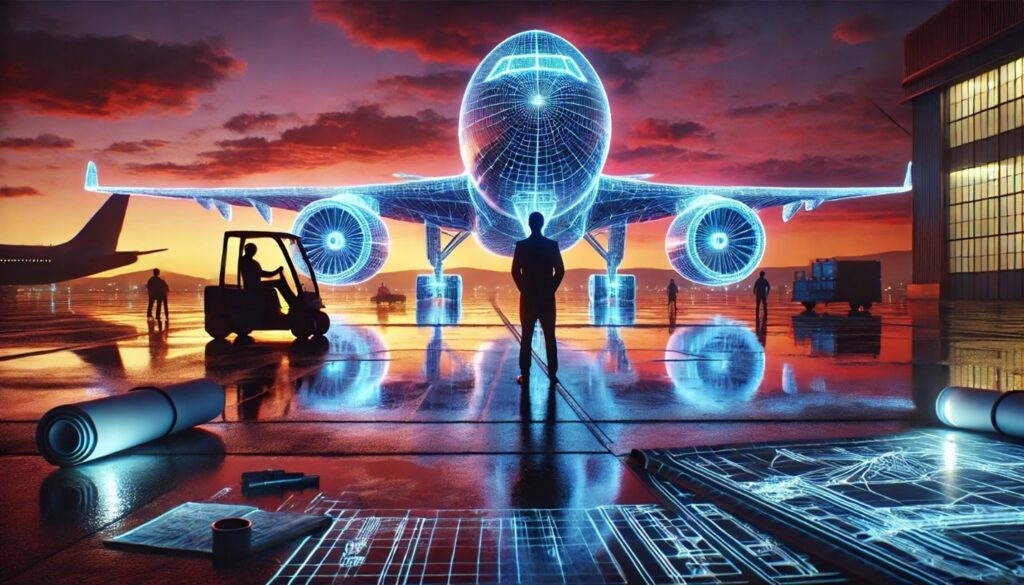Abstract
Aircraft maintenance has traditionally relied on scheduled inspections and reactive repairs—an approach that can lead to unexpected downtime, excessive costs, and inefficiencies in fleet management. However, digital twin technology is transforming this process by providing real-time insights, enabling predictive maintenance, and optimizing decision-making.
A digital twin is more than just a static model; it is a dynamic, data-driven virtual replica of an aircraft or its components that continuously updates based on real-world conditions. By leveraging digital twins, engineers can simulate performance, predict potential failures before they occur, and fine-tune maintenance schedules to maximize operational efficiency. This shift toward condition-based maintenance reduces costs, enhances reliability, and improves overall safety.
This article explores the role of digital twins in modern aircraft maintenance, their key benefits, and how integrating them with the 3DEXPERIENCE platform unlocks even greater potential for predictive aviation technology.
What is a Digital Twin?
A digital twin is a dynamic, real-time virtual replica of a physical object, system, or process. Unlike a simple 3D model, a digital twin continuously updates using live data from IoT sensors, machine learning algorithms, and historical records to mirror the real-world performance of an asset. This makes it more than just a visual representation—it’s a functional, data-driven model that evolves alongside its physical counterpart.
In the context of aerospace, a digital twin of an aircraft, engine, or individual component allows engineers to monitor wear and tear, analyze operational efficiency, and predict potential failures before they happen. By leveraging advanced simulations and predictive analytics, digital twins offer invaluable insights that go beyond traditional maintenance strategies.
It’s important to distinguish between digital twins and virtual twins. While both replicate physical assets in a digital space, a digital twin focuses primarily on real-time data collection and operational insights, allowing for predictive maintenance and performance optimization. A virtual twin, on the other hand, takes this a step further by integrating advanced simulation, AI-driven decision-making, and lifecycle management tools to continuously refine and optimize a product throughout its entire lifecycle.
This shift from static documentation to intelligent, self-updating models is revolutionizing aircraft maintenance. With real-time insights into an aircraft’s health, maintenance teams can transition from scheduled servicing to proactive, condition-based maintenance—ultimately reducing costs, improving reliability, and enhancing safety.
How Digital Twins Enhance Aircraft Maintenance
1. Predictive Maintenance and Failure Prevention
Traditional maintenance operates on a fixed schedule, leading to unnecessary part replacements or, worse, unexpected failures. Digital twins use real-time data analytics to forecast potential issues before they occur.
- AI-driven models analyze flight conditions, engine strain, and environmental factors to predict component degradation.
- Maintenance teams receive early warnings about potential failures, allowing them to schedule repairs before breakdowns occur.
- This condition-based approach extends component lifespan, reduces costs, and minimizes flight delays.
2. Real-Time Monitoring and Performance Optimization
Digital twins enable continuous real-time tracking of aircraft systems, detecting performance fluctuations that indicate underlying problems.
- Sensors embedded in engines, wings, and avionics provide instant feedback on system health.
- Data-driven simulations adjust flight operations for fuel efficiency and reduced wear on critical parts.
- Pilots and ground crews access live digital twin insights to fine-tune aircraft handling and minimize stress on components.
3. Reducing Aircraft Downtime and Maintenance Costs
Unexpected maintenance issues can ground aircraft, leading to financial losses and operational disruptions. Digital twins optimize fleet management by:
- Minimizing unplanned repairs through predictive analytics.
- Extending the maintenance cycle by servicing only when needed.
- Optimizing spare part inventory, ensuring components are available exactly when required.
This shift toward on-demand maintenance reduces unnecessary expenditures and keeps aircraft in the air longer.
4. Enhancing Safety and Compliance
Aerospace maintenance must comply with strict FAA, EASA, and ICAO regulations. Digital twins streamline compliance tracking by:
- Recording every part’s history, ensuring traceability and certification readiness.
- Running AI-powered simulations to test how components respond to different stress conditions.
- Providing digital documentation for audits, reducing the administrative burden on airlines and MRO providers.
With digital twins, engineers can confidently validate repairs, conduct virtual inspections, and ensure regulatory adherence in real time.
Leveraging Digital Twin Technology on the 3DEXPERIENCE Platform
The 3DEXPERIENCE platform provides a centralized ecosystem where digital twin technology integrates seamlessly with advanced simulation, data analytics, and lifecycle management tools. By leveraging this powerful platform, aerospace companies can enhance aircraft maintenance through:
- Unified Data Management: The 3DEXPERIENCE platform consolidates real-time data from IoT sensors, flight logs, and maintenance records, providing a single source of truth for engineers, maintenance teams, and operators.
- Advanced Simulations: Engineers can use industry-leading tools like SIMULIA to run high-fidelity simulations on digital twin models, testing various operating conditions and optimizing maintenance strategies.
- Collaborative Decision-Making: With cloud-based accessibility, stakeholders across the aerospace industry can collaborate in real time, using digital twins to refine designs, improve maintenance workflows, and ensure regulatory compliance.
- AI-Powered Predictive Insights: The platform’s AI-driven analytics enhance predictive maintenance, reducing unplanned downtime and improving operational efficiency.
By integrating digital twin technology with the 3DEXPERIENCE platform, aerospace companies can shift from reactive maintenance to a data-driven, proactive strategy—enhancing safety, optimizing costs, and ensuring peak aircraft performance.
To learn more about how Mecanica can help implement digital twin solutions on the 3DEXPERIENCE platform, contact our team today.


